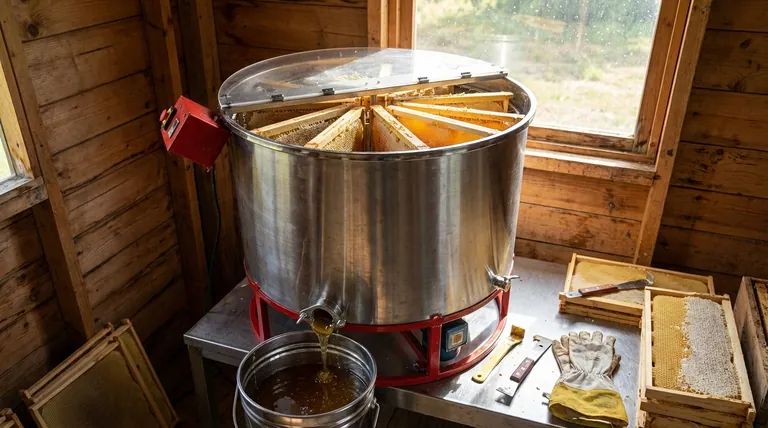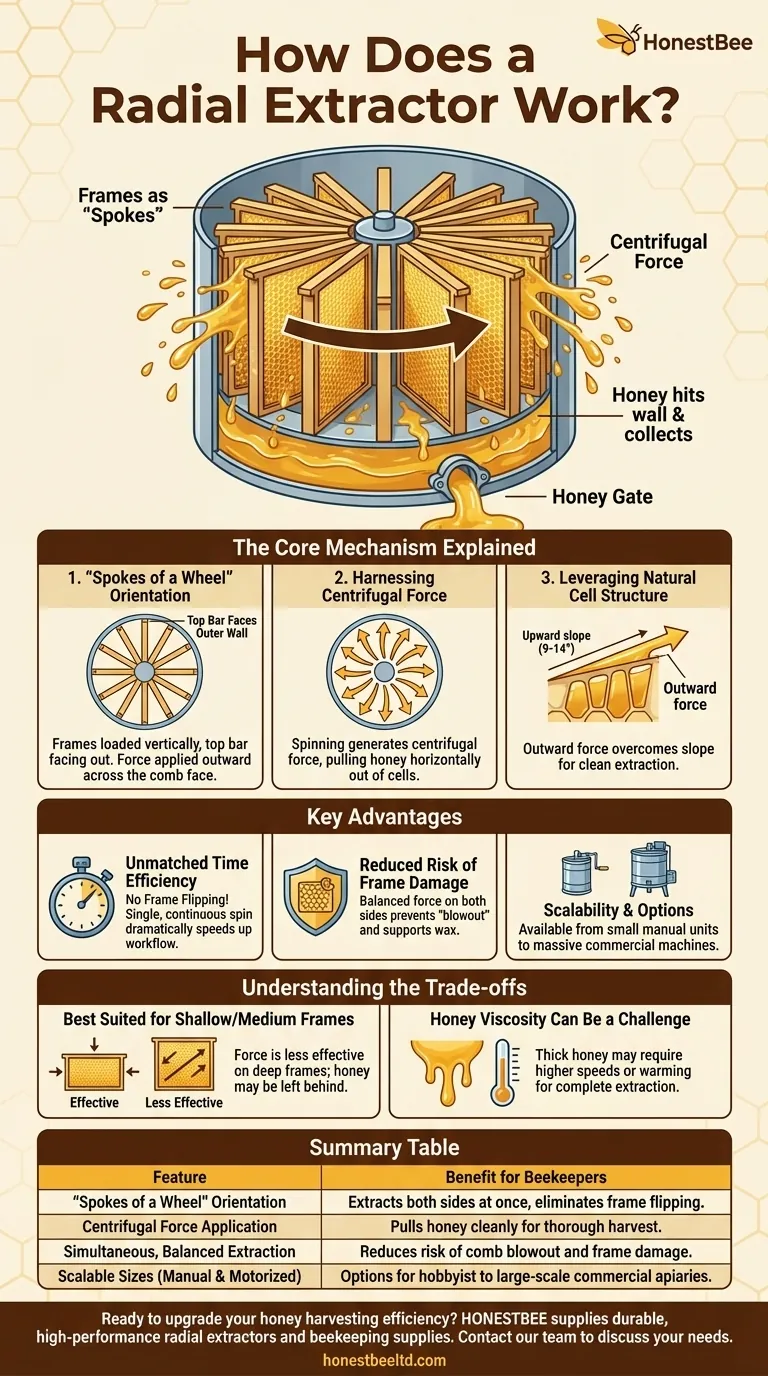At its core, a radial extractor works by positioning honey frames like the spokes of a wheel and using centrifugal force to pull honey from both sides of the comb simultaneously. The frames are oriented with their top bars facing the outer wall of the drum. As the extractor spins, honey is thrown outward and downward, hitting the wall and collecting at the bottom.
The fundamental advantage of a radial extractor is its efficiency. By extracting honey from both sides of the frame at once, it eliminates the need to stop and flip the frames, significantly reducing the time and labor required for honey harvesting.

The Core Mechanism Explained
A radial extractor’s design is a clever application of physics tailored specifically to the structure of a honeycomb. Understanding its mechanics reveals why it has become a standard for many beekeepers.
The "Spokes of a Wheel" Orientation
Frames are loaded into the extractor's basket vertically, with the top bar of each frame facing the outside wall. This arrangement is the defining characteristic of a radial design.
This orientation ensures that as the basket spins, the force is applied outward across the face of the comb.
Harnessing Centrifugal Force
When the basket rotates at speed, a powerful centrifugal force is generated. This force acts on the honey within the cells, pulling it horizontally out of the comb.
The honey travels from the comb to the inner wall of the extractor drum, where it drips down to a collection point at the bottom, ready to be drained through a honey gate.
Leveraging Natural Cell Structure
Worker bees build honeycomb cells with a slight upward slope, typically between 9 and 14 degrees. This prevents honey from running out before the cell is capped with wax.
The radial extractor’s design takes advantage of this. The outward force easily overcomes the slight upward angle of the cells on both sides of the frame, allowing for a clean and simultaneous extraction.
Key Advantages of the Radial Design
The primary benefit is speed, but the design offers other significant advantages that impact the quality of the extraction process and the health of the equipment.
Unmatched Time Efficiency
The single greatest advantage is that you do not have to turn the frames. In other types of extractors, you must extract one side partially, flip all the frames, extract the second side fully, and then flip them back to finish the first side.
A radial extractor turns this multi-step process into a single, continuous spin, dramatically speeding up the workflow for the beekeeper.
Reduced Risk of Frame Damage
Because centrifugal force is applied evenly and simultaneously to both sides of the comb, the wax foundation is well-supported.
This balanced force significantly reduces the risk of a "blowout," where the pressure of heavy, unextracted honey on one side breaks the delicate wax comb of the other.
Scalability and Options
Radial extractors are available in a wide range of sizes, from small 6-frame manual units for hobbyists to massive 20+ frame motorized machines for commercial operations.
This scalability means there is a radial option suitable for nearly any size of apiary.
Understanding the Trade-offs
While highly effective, the radial design is not without its limitations. Its performance is directly tied to frame size and the type of honey being harvested.
Best Suited for Shallow or Medium Frames
The reference notes that radial extractors are "perfect" for low-height frames. This is a critical point. The centrifugal force is most effective when it is perpendicular to the comb surface.
On taller, "deep" frames, the force hits the bottom of the comb at a much sharper angle, making it less effective. This can result in honey being left behind at the bottom of these larger frames.
Honey Viscosity Can Be a Challenge
Thick, viscous honey (like that from canola or certain late-season nectars) can be more difficult to extract.
In a radial extractor, this may require higher rotational speeds or warming the honey-filled frames beforehand to reduce viscosity and ensure a complete extraction.
Making the Right Choice for Your Apiary
Selecting the right extractor depends entirely on the scale of your operation and the type of equipment you use.
- If your primary focus is speed and efficiency with many hives: A motorized radial extractor is the definitive choice, especially if you use medium or shallow honey supers.
- If you are a hobbyist with only a few hives: A small manual radial extractor offers a significant time-saving over other types and is a worthwhile investment.
- If you primarily use deep frames for honey: You must either accept less efficient extraction with a radial or consider a tangential extractor, which is designed to handle deep frames more effectively.
Ultimately, understanding the principles of radial extraction empowers you to choose the tool that best aligns with your beekeeping goals.
Summary Table:
| Feature | Benefit for Beekeepers |
|---|---|
| "Spokes of a Wheel" Frame Orientation | Extracts honey from both sides of the comb at once, eliminating the need to flip frames. |
| Centrifugal Force Application | Pulls honey cleanly from the cells, ensuring a thorough harvest. |
| Simultaneous, Balanced Extraction | Reduces the risk of comb blowout and frame damage, protecting your valuable equipment. |
| Scalable Sizes (Manual & Motorized) | Offers options suitable for hobbyist beekeepers to large-scale commercial apiaries. |
Ready to upgrade your honey harvesting efficiency?
HONESTBEE supplies durable, high-performance radial extractors and a full range of beekeeping supplies to commercial apiaries and beekeeping equipment distributors. Our wholesale-focused operations ensure you get the reliable equipment you need to maximize your productivity.
Contact our team today to discuss the best radial extractor for your operation and explore our full catalog of wholesale beekeeping solutions.
Visual Guide

Related Products
- HONESTBEE 72 Frame Industrial Electric Honey Extractor for Beekeeping
- 6 Frame Manual Stainless Steel Honey Extractor Beekeeping Equipment
- HONESTBEE 3-Frame Manual Acrylic Honey Extractor
- 8-Frame Electric Self-Reversing Honey Extractor Spinner for Commercial Honey Extraction Equipment
- Plastic Hand Crank 2 Frame Honey Extractor Low Price
People Also Ask
- What are the advantages of automatic honey extractors? Scale Your Apiary with Unmatched Efficiency
- What should a beekeeper do after extracting honey from supers? A Guide to Harvest Management
- What is the energy consumption like for automatic honey extractors? Maximize Your Harvest Efficiency
- What are the advantages of automated honey extractors in terms of time efficiency? Boost Your Harvest Speed
- Why do beekeepers have to lift a lot of weight at the end of a growing season? The Reward of a Heavy Harvest



















